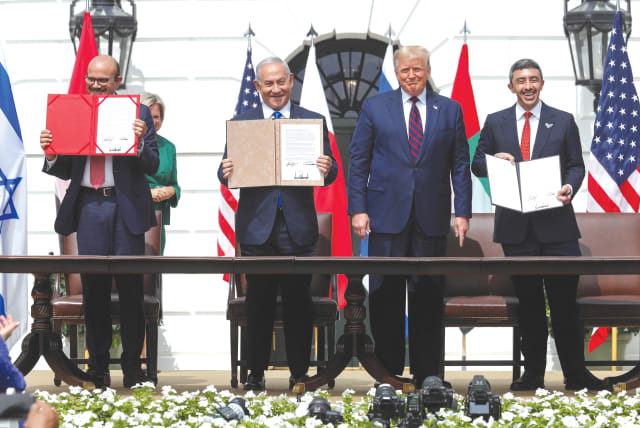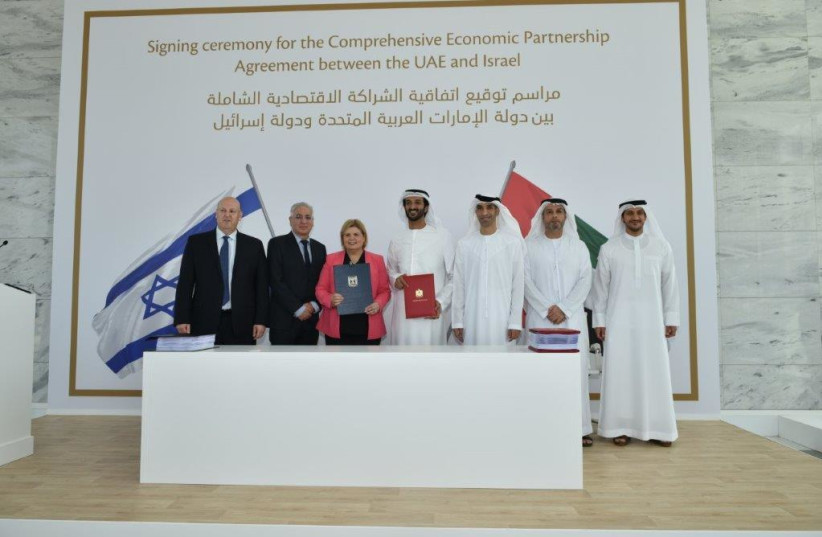US can counter China in the Middle East with Abraham Accords free trade - opinion

Such a free trade area would enable the countries of the Abraham Accords and eventually, the wider MENA region while constraining China’s predatory economic practices.
China’s growing influence in the Middle East, demonstrated by its role in mediating the recent Saudi-Iran rapprochement, is a threat to the vital economic and security interests of the United States and its allies. In response, the US should undertake bold and farsighted moves to deepen mutually-beneficial strategic cooperation with its regional partners, through new multilateral frameworks, including in the economic arena.
One extremely important initiative would be the establishment of an Abraham Accords free trade area. Such a free trade area would enable the countries of the Abraham Accords and eventually, the wider MENA region to accelerate their aspirations for sustained economic growth and diversification while preserving the integrity of global markets and constraining China’s predatory economic practices.
The historic Abraham Accords, signed in 2020, have already led to rapid growth in trade and cooperation in a wide range of areas from investment and innovation to food security and health. Israel and the UAE have completed a Comprehensive Economic Partnership Agreement and negotiations for a similar agreement between Israel and Bahrain are underway. Total trade between Israel and its regional peace partners reached $3.47 billion (NIS 12.7 b.) in 2022, up from $1.905 b. (NIS 7 b.) in 2021 and $593 b. (NIS 2.2 b.) in 2019.
However, the truly transformative potential of the Abraham Accords lies in expanding multilateral cooperation and integration among its members. According to a RAND analysis, the benefits of a multi-lateral free trade agreement (FTA) encompassing current Abraham Accords signatories could create more than 150,000 new jobs and new economic activity exceeding $75 b. (NIS 275 b.).
A multi-lateral FTA among an expanded number of potential signatories to the Abraham Accords could create as many as four million new jobs and $1 trillion (NIS 3.7 t.) in new economic activity through 2030.
Free trade area attempts in the Middle East
There have been several attempts to create Middle East free trade areas in the past. In 1997, 14 Arab states established the Greater Arab Free Trade Area. In 2003, the Gulf Cooperation Council (GCC) launched a Customs Union. And in 2004, Jordan, Tunisia, Egypt and Morocco signed the Agadir Agreement, which called for the creation of a free trade zone between the Arab Mediterranean nations as a first step toward the potential formation of a Euro-Mediterranean free trade area.
Yet despite these and other agreements, intra-Arab non-oil trade remains quite low, at under 10% of Arab countries’ total trade. Numerous non-tariff barriers remain and the region has failed to achieve its potential for economic growth.
In 2003, the US proposed the Middle East Free Trade Area Initiative (MEFTA), a plan of graduated steps for Middle Eastern nations to increase trade and investment with the US and other global partners, towards the goal of creating a US and Middle East free trade area by 2013.
While such a free trade area was never established, the US signed a constellation of preferential trading agreements, including trade and investment framework agreements, bilateral investment treaties and comprehensive FTAs with the countries of the region. Bilateral FTAs with Israel, Jordan, Morocco, Bahrain and Oman are currently in effect.
At the same time, over the last several decades, China has built strategic or cooperative partnerships with eight Arab countries and has set up a strategic dialogue mechanism with the GCC as part of a comprehensive strategy for the Middle East. Arab countries have become China’s largest source of crude oil and its 7th biggest trading partner.
Chinese President Xi Jinping’s visit to Riyadh in December 2022, which included China-Saudi, China-GCC and China-Arab summits and the signing of 34 economic agreements, heralded the growing influence of China in the region. This influence found expression once again this month in Beijing’s mediation of the Saudi-Iran agreement to reopen their embassies.
US must counter Chinese economic influence in the Middle East
The US should not continue with business as usual in light of this reality. The Chinese Community Party represents one of the most significant threats to the US and its allies.
China’s state-directed economic policies, predatory lending, cyber intrusions, theft of intellectual property, illicit technology transfer, industrial subsidies, market access restrictions and other coercive measures, constitute the most significant threats of the coming century. Through its Road and Belt Initiative, China is extending its influence over key transport hubs throughout the region.
IN ORDER to counter China’s economic influence and promote a regional trade order favorable to the US and its partners, the US should work to establish an Abraham Accords free trade area, with the eventual goal of both expanding the accords and establishing a broader Middle East free trade area by the end of the decade.
In order to make such a free trade area a reality, the US and accord members should map the complex array of barriers and impediments to integration and provide options to address each. The US trade representative (USTR) should convene trade ministers and appropriate counterparts from Abraham Accord member nations, potentially in the framework of the Negev Forum, to discuss the potential benefits, parameters and an incremental approach to establishing a free trade area by 2025.
These discussions could build upon the first Trade and Investment Forum convened by the Abraham Accords Peace Institute in December 2021, which brought together senior public and private decision-makers from the Abraham Accord countries to assess economic progress, prioritize strategies to optimize trade and investment and advance multilateral initiatives to realize the full potential of the Abraham Accords.
The USTR should also complete free trade agreements with Abraham Accord members who do not already enjoy their benefits, as well as with other key regional allies, such as Saudi Arabia. Having done so, the dividends of cumulation could be leveraged. European and Asian trading partners should also meet to consider how their own constellation of trade agreements can create mutually-beneficial synergies with the countries of the Abraham Accords.
Building upon past efforts at economic integration, driven by the Abraham Accords’ spirit of mutually-beneficial cooperation and informed by the need to counter malign Chinese activities, a US-led Abraham Accords free trade area could help ensure a regional future of prosperity and peace. Now is the time to turn this vision into a reality.
The writer served as the deputy assistant to the president of the US and the senior director for Middle Eastern and North African affairs until January 2021 and is the president and the executive director of the Abraham Accords Peace Institute.
Jerusalem Post Store
`; document.getElementById("linkPremium").innerHTML = cont; var divWithLink = document.getElementById("premium-link"); if (divWithLink !== null && divWithLink !== 'undefined') { divWithLink.style.border = "solid 1px #cb0f3e"; divWithLink.style.textAlign = "center"; divWithLink.style.marginBottom = "15px"; divWithLink.style.marginTop = "15px"; divWithLink.style.width = "100%"; divWithLink.style.backgroundColor = "#122952"; divWithLink.style.color = "#ffffff"; divWithLink.style.lineHeight = "1.5"; } } (function (v, i) { });

